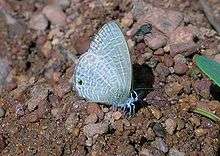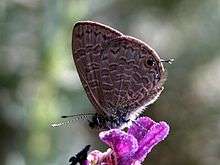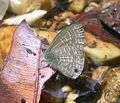Prosotas nora
| Common lineblue | |
|---|---|
 | |
| Scientific classification | |
| Kingdom: | Animalia |
| Phylum: | Arthropoda |
| Class: | Insecta |
| Order: | Lepidoptera |
| Family: | Lycaenidae |
| Genus: | Prosotas |
| Species: | P. nora |
| Binomial name | |
| Prosotas nora | |

Prosotas nora, the common lineblue, is a species of lycaenid butterfly found in Asia.
Description
_in_Anantgiri%2C_AP_W_IMG_8820.jpg)
Male upperside: purplish brown or purplish with a dark tint, some specimens brown with a very slight purplish sheen seen only in certain lights. Forewings and hindwings: nearly uniform, both with slender black anticiliary lines, the hindwing in addition with the costal and dorsal margins paler; in most specimens with a subterminal black spot in interspace 2, sometimes seen only by transparency from the underside; tail black tipped with white. Underside: brown, hoary, brownish or pale dull brown. Forewing: a subbasal pair of transverse white strigae, a shorter pair along the discocellulars and a discal pair; these strigae all narrowly edged on the inner sides of each pair with fuscous which gives the appearance of transverse bands somewhat darker than the ground colour; the subbasal pair extend from vein 1 to vein 12, the discocellular pair from upper to lower apex of cell and the discal pair are very irregular and dislocated at each vein, the whole having the appearance of a dark sinuous band; terminal markings often very faint and ill defined or again fairly prominent and consisting of a double subterminal series of transversely linear, sometimes lunular, dark spots, with edgings paler than the ground colour; lastly, an anticiliary dark line. Hindwing: with transverse pairs of white, inwardly fuscous-edged strigae similar to those on the forewing, but even more irregular and broken; the subbasal pair extended from costa to vein 1, below which the dorsal area is whitish, the discocellular pair extend from the costa and posteriorly coalesce with the discal pair which are as irregular and dislocated as in the forewing; terminal markings similar to those on the forewing, but the double subterminal series of dark spots more lunular and a prominent round black subterminal spot crowned with ochraceous in interspace 2. Antenna, head, thorax and abdomen dark brown; the shafts of the antennae speckled with white; beneath: the palpi fringed with black, thorax dark greyish brown, abdomen white.[1]

Female upperside: brownish purple, sometimes fuscous. Forewings and hindwings: as in the male with anticiliary dark lines, but differ as follows: Forewing: an iridescent bluish sheen from base outwards to disc; hindwing; a slender more or less prominent white line edging the anticiliary black line on the inner side, a sub terminal geminate (paired) double black spot in interspace 1 and a similar larger single spot in interspace 2. Underside: ground colour paler and brighter than in the male, the markings similar but more neatly and generally more clearly defined; both forewings and hindwings in most of the specimens have a white terminal line before the anticiliary dark line. Antennae, head, thorax and abdomen much as in the male.[1]
Distribution
Peninsular India from the outer Himalayas to Travancore, avoiding the desert tracts; Sri Lanka; Assam; Burma; Tenasserim; the Andamans and Nicobars; extending into the Malayan subregion and to the Philippines.[1]
Gallery
_in_Hyderabad%2C_AP_W_IMG_0509.jpg) In Hyderabad, India
In Hyderabad, India_in_Hyderabad%2C_AP_W_IMG_0503.jpg) In Hyderabad
In Hyderabad_in_Hyderabad%2C_AP_W_IMG_0502.jpg) In Hyderabad
In Hyderabad_in_Hyderabad%2C_AP_W_IMG_0242.jpg) In Hyderabad
In Hyderabad From Kodagu in the Western Ghats of India
From Kodagu in the Western Ghats of India_W_IMG_2843.jpg)
_W_IMG_2840.jpg) At the Ananthagiri Hills, in Rangareddy district of Andhra Pradesh, India
At the Ananthagiri Hills, in Rangareddy district of Andhra Pradesh, India_on_Peristrophe_paniculata_W_IMG_4172.jpg) In Hyderabad
In Hyderabad
See also
| Wikimedia Commons has media related to Prosotas nora. |
| Wikispecies has information related to: Prosotas nora |
Cited references
- 1 2 3 Bingham, C.T. (1907). The Fauna of British India, Including Ceylon and Burma. II (1st ed.). London: Taylor and Francis, Ltd.
References
- Beccaloni, George; Scoble, Malcolm; Kitching, Ian; Simonsen, Thomas; Robinson, Gaden; Pitkin, Brian; Hine, Adrian; Lyal, Chris. "The Global Lepidoptera Names Index (LepIndex)". Natural History Museum, London. Retrieved 2016-10-15.
- Evans, W.H. (1932). The Identification of Indian Butterflies (2nd ed.). Mumbai, India: Bombay Natural History Society.
- "Markku Savela's website on Lepidoptera".
- Wynter-Blyth, Mark Alexander (1957). Butterflies of the Indian Region. Bombay, India: Bombay Natural History Society. ISBN 978-8170192329.
External links
- Asahi Correctly determined photos of P. nora from the Philippines